Scioly Anatomy and Physiology
1/173
There's no tags or description
Looks like no tags are added yet.
Name | Mastery | Learn | Test | Matching | Spaced |
|---|
No study sessions yet.
174 Terms
Parietal Lobe
A lobe in the cerebrum that interprets language/words, sense of touch, pain temperature, and spacial/visual perception
B
Parietal lobe
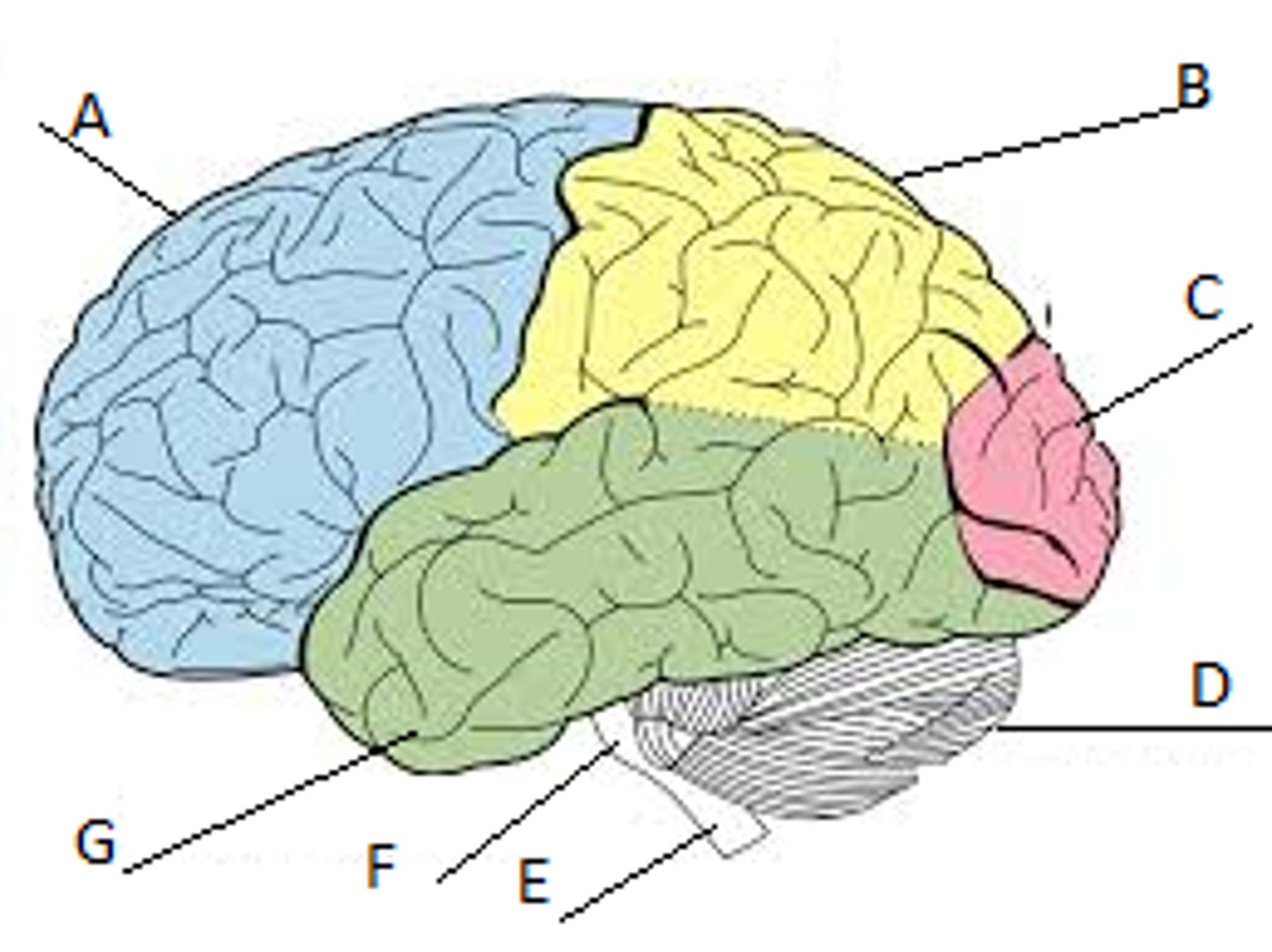
Frontal Lobe
A lobe in the cerebrum that deals with personality, behavior, emotion, judgment, planning, problem solving, speech and writing, body movement, intelligence, concentration, and self awareness.
A
Frontal lobe
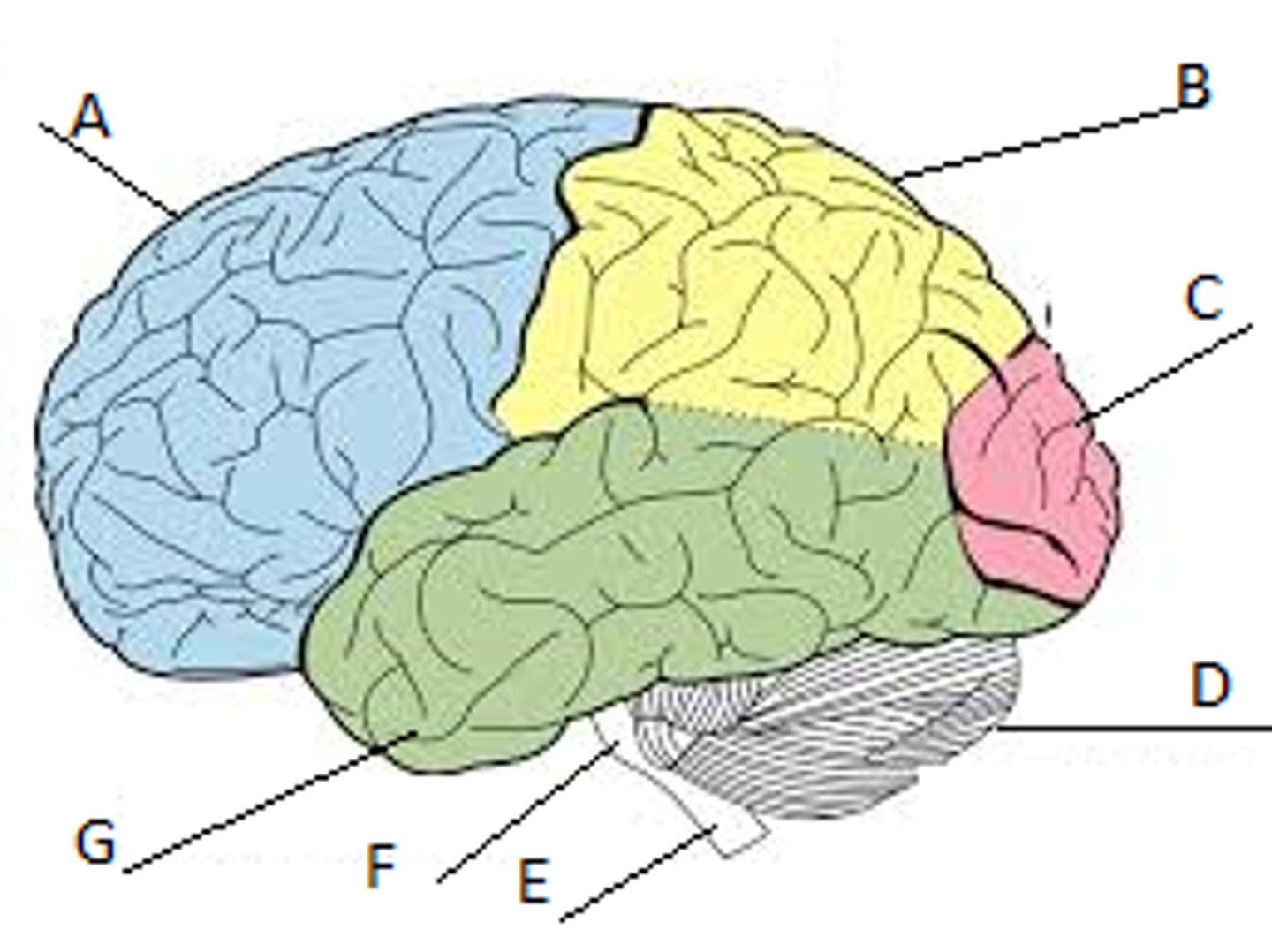
Occipital lobe
A lobe in the cerebrum that interprets vision (color, light, movement)
C
Occipital lobe
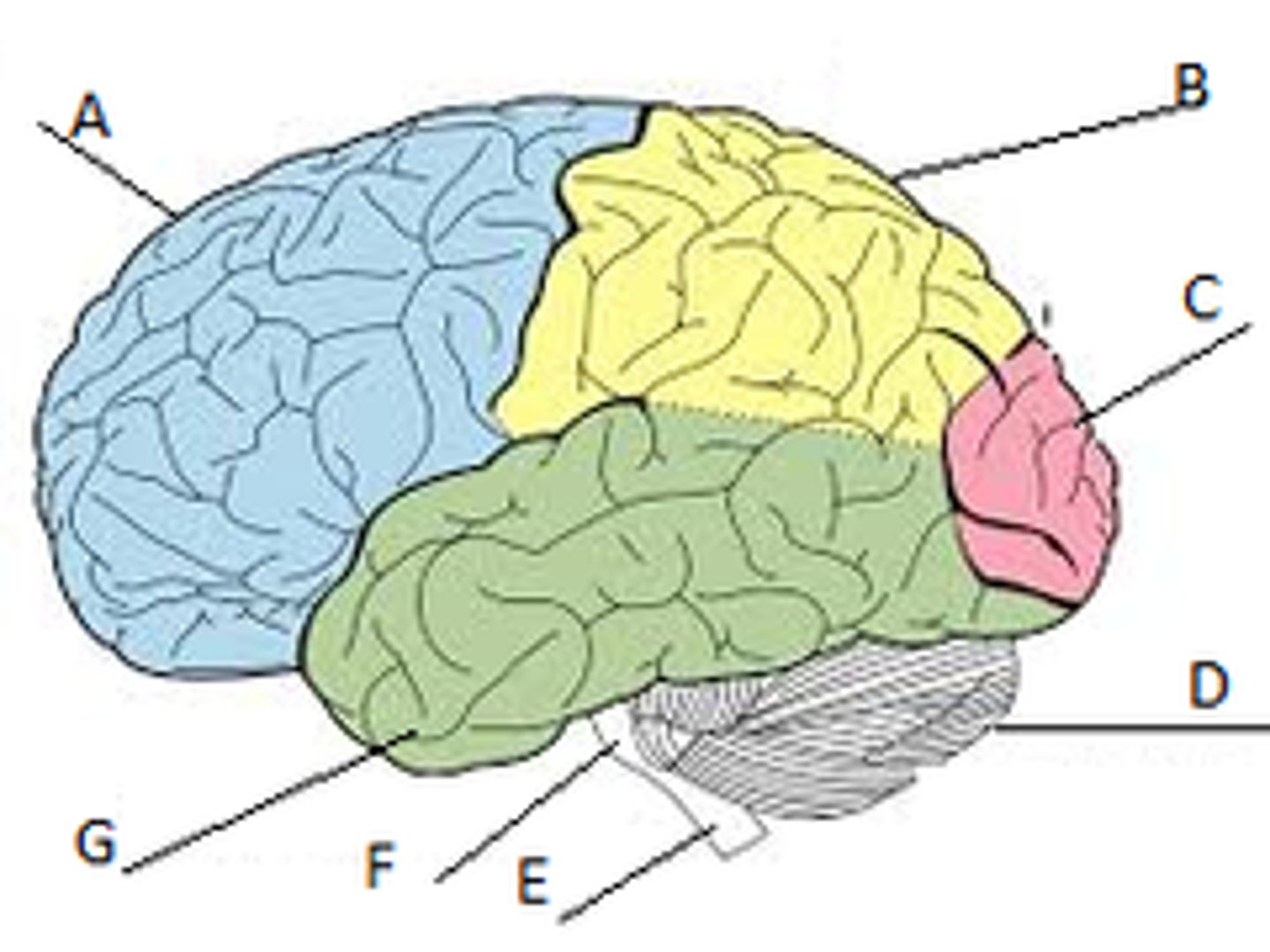
Temporal Lobe
A lobe in the cerebrum that understands language instead of just interpreting it/recognizing it like the parietal lobe, understands and uses memory and hearing, sequencing and organization
Temporal lobe
G
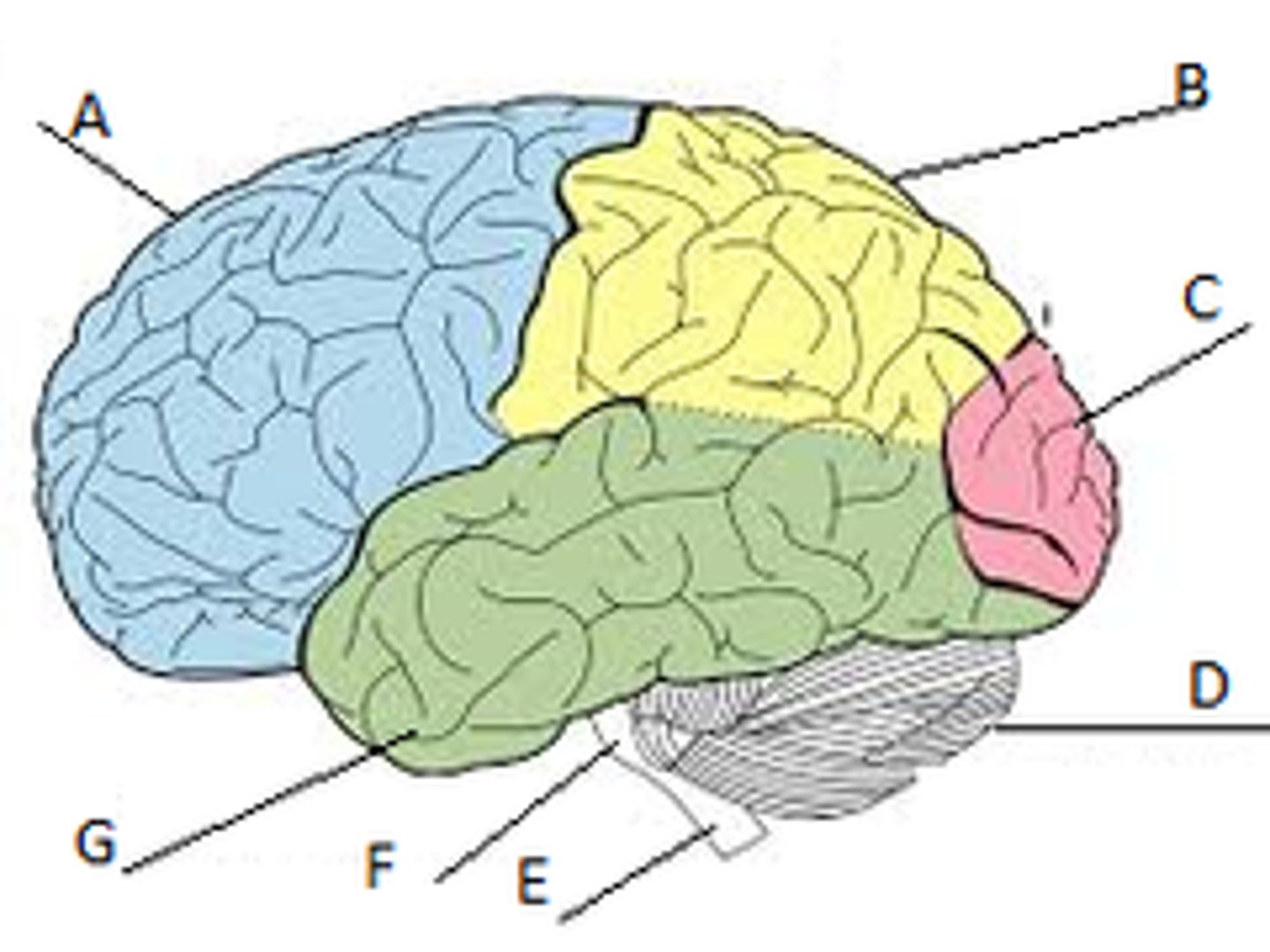
Broca's area
located in the frontal lobe on the left side of the brain, responsible for regulating breathing patterns while speaking and vocalizations necessary for speech, along with speech articulation
Broca's area
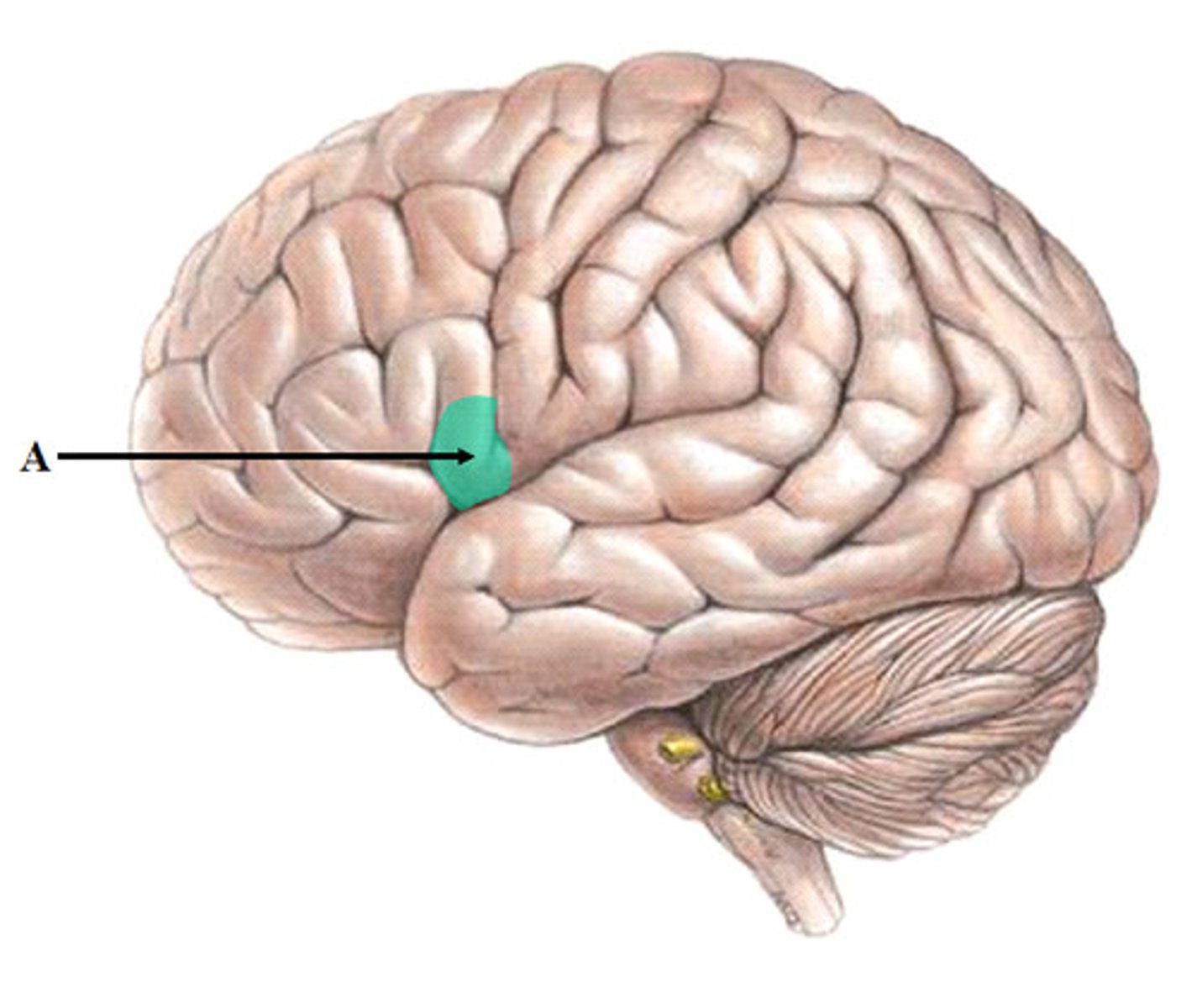
Broca's aphasia
A disorder that occurs when the Broca's area is damaged; with the person having difficulty producing the sounds of speech, however, they can still understand spoken and written language
arcuate fasciculus
A neuronal tract that connects the Broca's area to other regions of the brain such as the Wernicke's area
Wernicke's Area
Located in the temporal lobe of the brain, responsible for the comprehension of speech
Wernicke's area
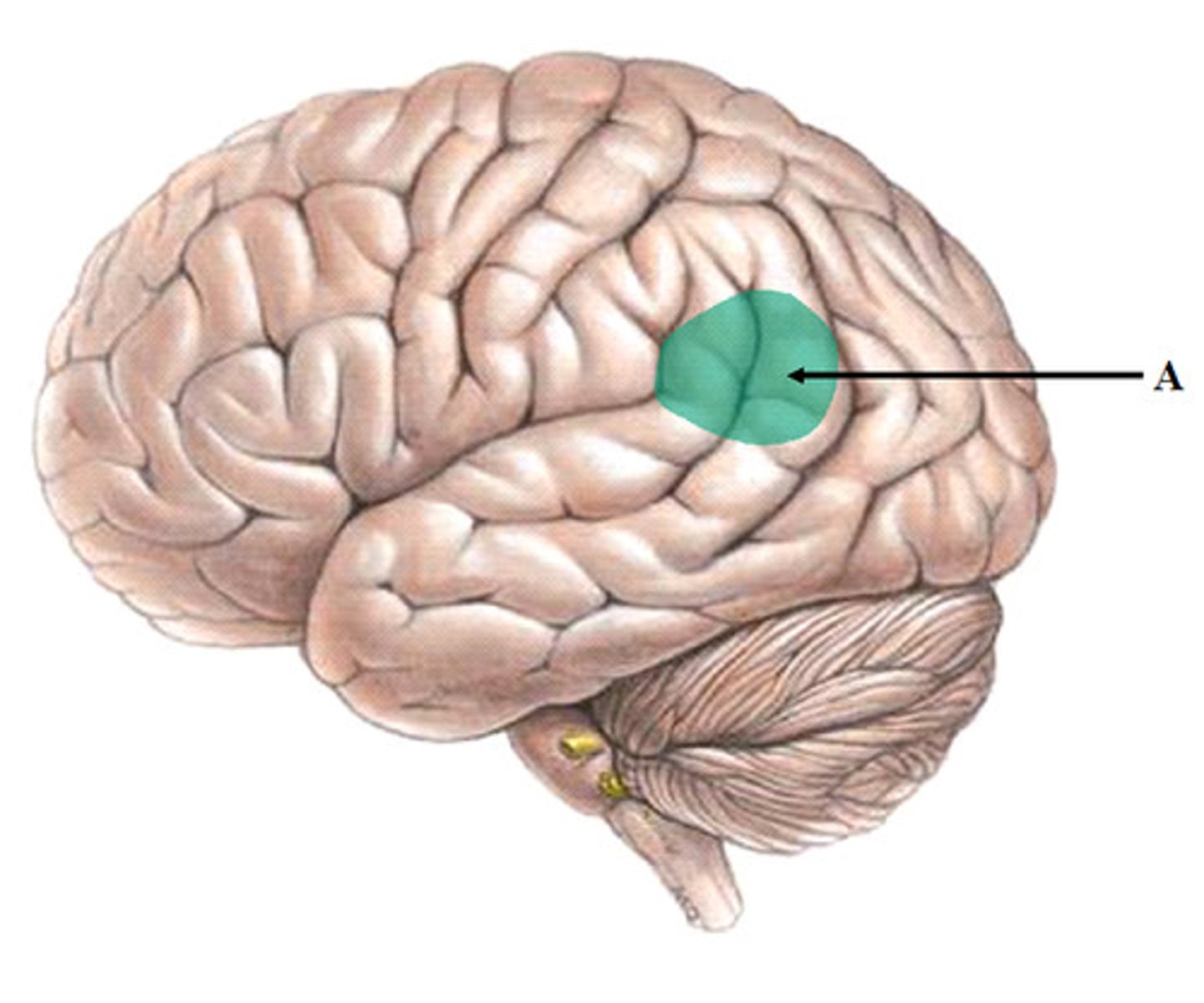
Wernicke's aphasia
A disorder that occurs when the Wernicke's area of the brain is damaged, with the person being able to make speech sounds that sound fluent but lack meaning; and because the person has difficulty understanding speech, they are unaware of their mistakes.
Limbic system
center of emotions, learning, and memory- composed of four parts: hypothalamus, thalamus, amygdala, and hippocampus
Name the image
Limbic System
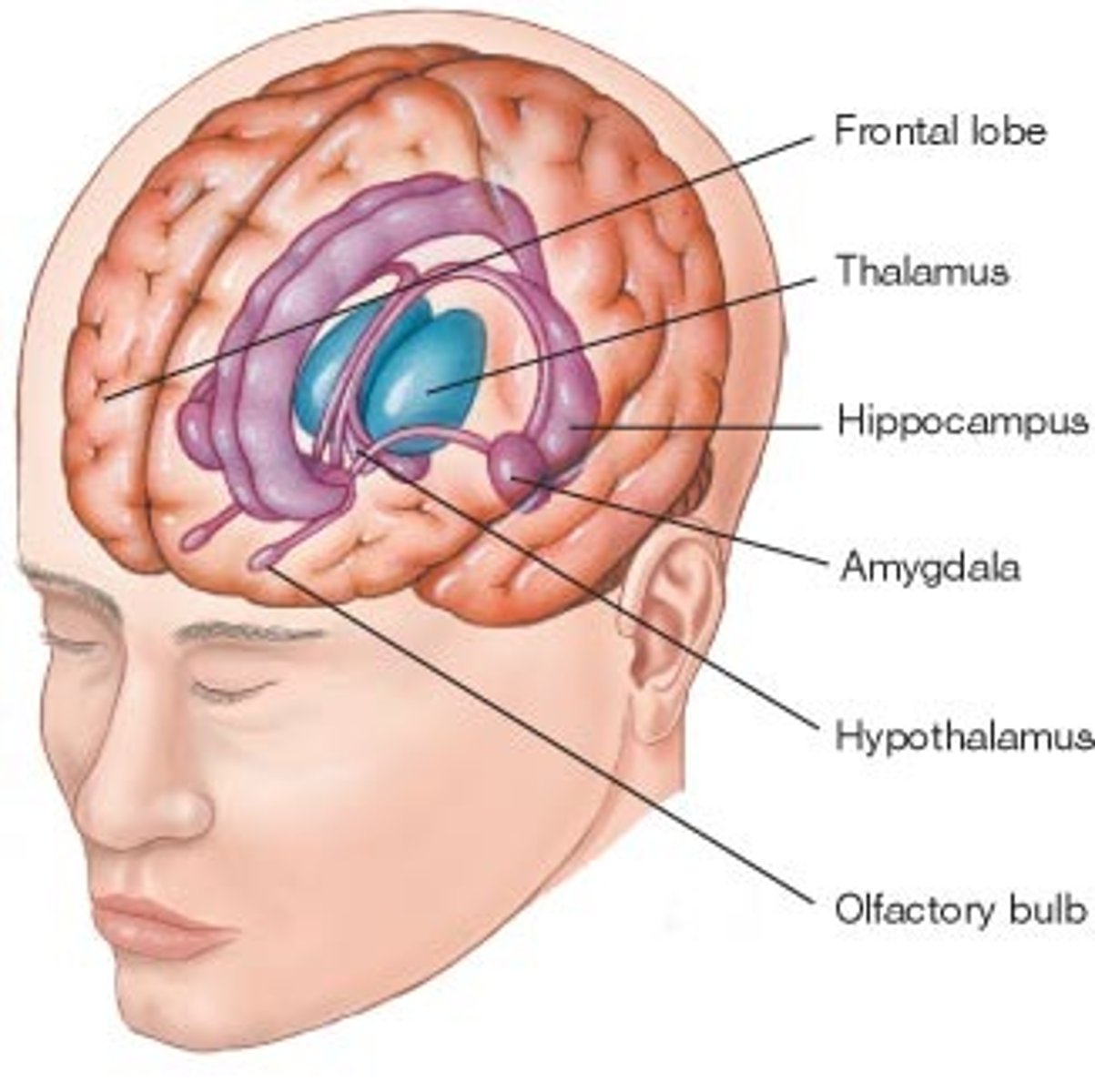
Pons
located in the brainstem, controls many eye and face movements, have sensory roles in sense of hearing, equilibrium, taste, touch, and pain
Blue area
Pons
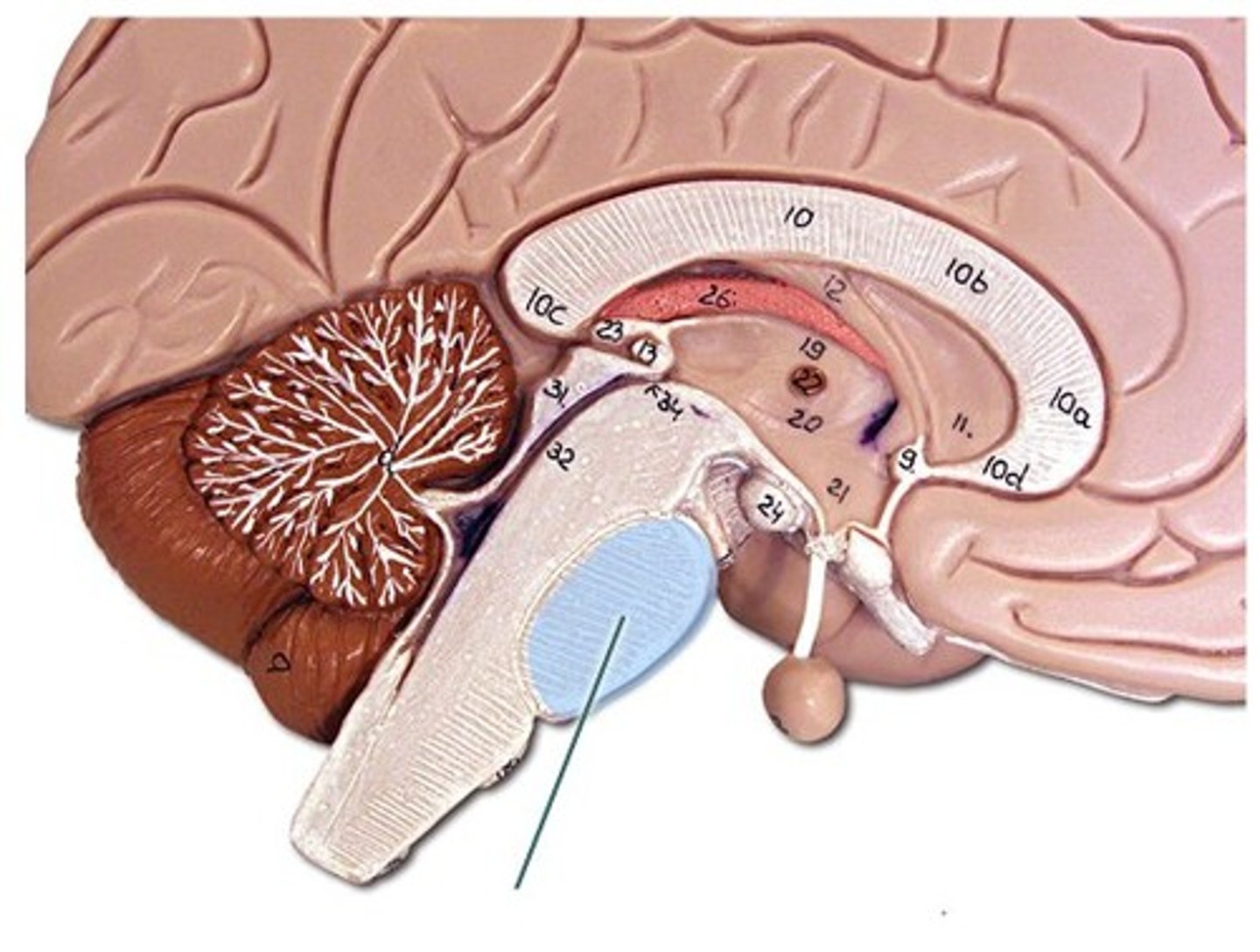
Midbrain
located in the brainstem, associated with vision, hearing, motor control, sleep and wake cycles, alertness, and temperature regulation
Midbrain
Label the image

Medulla
lower half of the brainstem that contains the cardiac, respiratory, vomiting, and vasomotor centers and regulates autonomic, involuntary functions such as breathing, heart rate, and blood pressure
Name of image
Medulla
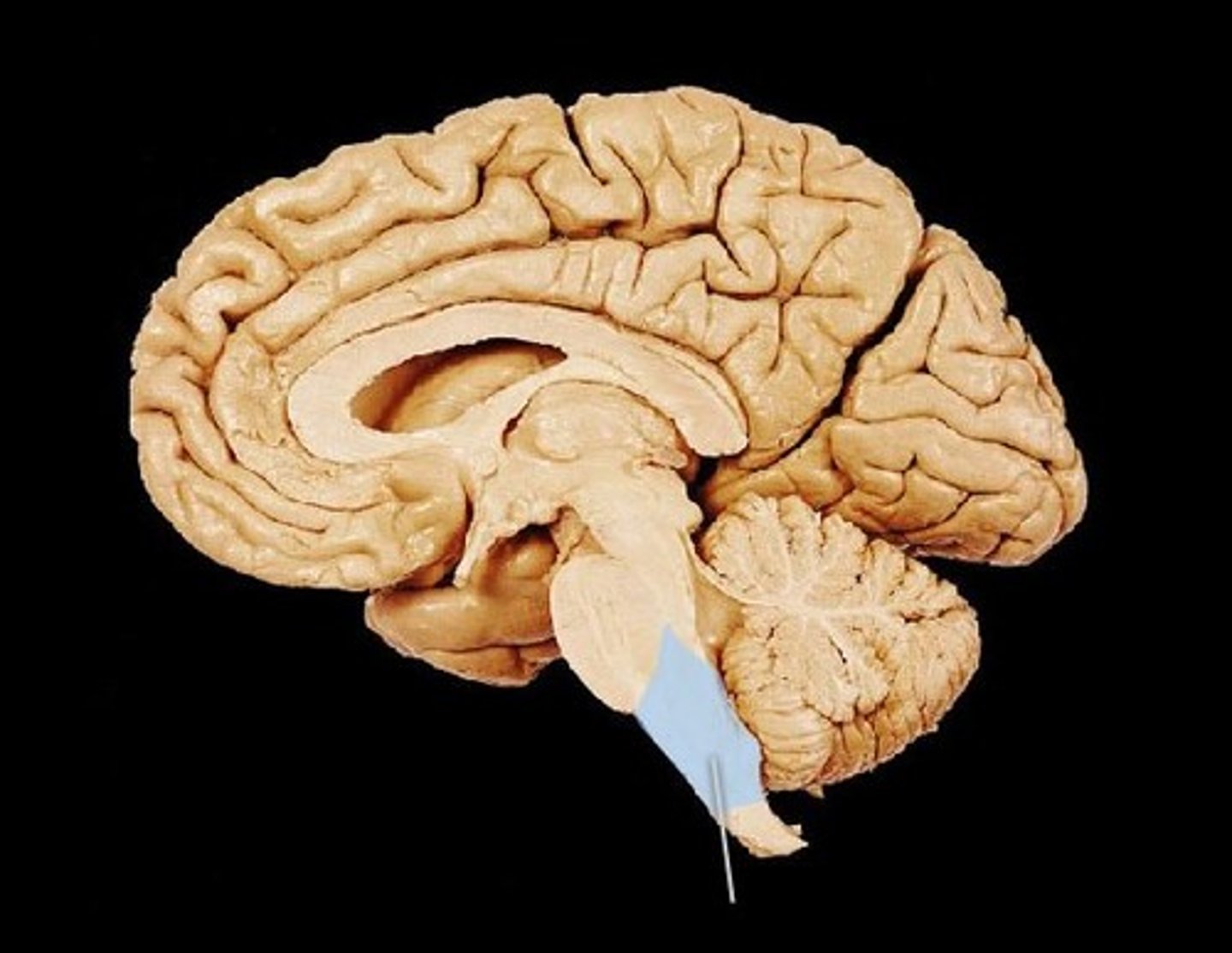
Delta Wave
lowest frequency brain wave, 0,1-.3.5 Hz. occur in deep sleep and other abnormal processes. Dominant rhythm in infants up to one year of age.
Why do we increase Delta waves?
To decrease our awareness of the physical world
Delta waves and ADD
Individuals with Attention deficit disorder naturally increase delta waves when trying to concentrate rather than decreasing them like normal
Theta waves
4-8 Hz, seen as relatively "slow" activity, a repository for memories, emotions, sensations, e.t.c. Seen in connection with creativity, intuition, daydreaming. Abnormal in awake adults but normal in children up to 13 years old.
Alpha waves
8-12 Hz, usually peaks around 10 Hz. Major rhythm in normal relaxed adults. Common state for the brain and occurs whenever a person is alert, but not actively processing information.
Experiencing good moods, seeing the world truthfully, and having a sense of calmness.
Alpha waves
Beta waves
above 12 Hz, "fast" activity. reflects desynchronized brain tissue and is generally regarded as a normal and dominant rhythm in those who are alert of anxious or who have their eyes open.
Gamma waves
Above 30 Hz, associated with a good memory with well regulated and efficient 40 Hz activity.
Sensory neurons
Bring information into the Central nervous system
Motor neurons
Bring information out of the Central nervous system
Peripheral nervous system
Split into Somatic and Autonomic nervous system
Autonomic nervous system
Split into parasympathetic and sympathetic nervous systems
Parasympathetic nervous system
Controls the body's organs during times of rest
Sympathetic nervous system
Controls the body's organs during times of stress
Axons
Long extensions that a motor neuron has that run from the CNS to the muscles they innervate
Ganglia
the cell bodies of other PNS neurons that can be found in clusters outside of the CNS
Neurons that get information from other neurons and convey the information to your muscles, organs, and glands
motor neurons
Neurons that get information about what is going on inside and outside of the body and bring that information into the CNS so it can be processed
Sensory neurons
Basic functions of a neuron
1. Receive signals 2. Interpret incoming signals to determine whether or not the information should be passed along 3. Communicate signals to target cells (other neurons, muscles, or glands)
Soma
A neuron's cell body, usually where incoming signals are received and integrated.
Where is a neuron's nucleus found?
The soma
Dendrites
Short, branching processes that extend from the cell body of a neuron. Normally receives and integrates incoming signals.
Excitatory signals
Signals that tend to make the neuron fire
Inhibitory signals
Signals that keep the neuron from firing
Spines
Bumps on the tapering of the dendrite
Axon
typically longer than a dendrite, do not have spines. Many of these are covered in an insulating substance called myelin that increases the rate at which electrical impulses (called action potentials) are passed along the axon
axon terminal or nerve terminal
bulbous swellings towards the end of the axon which make connections on target cells
Name this image
Axon terminal
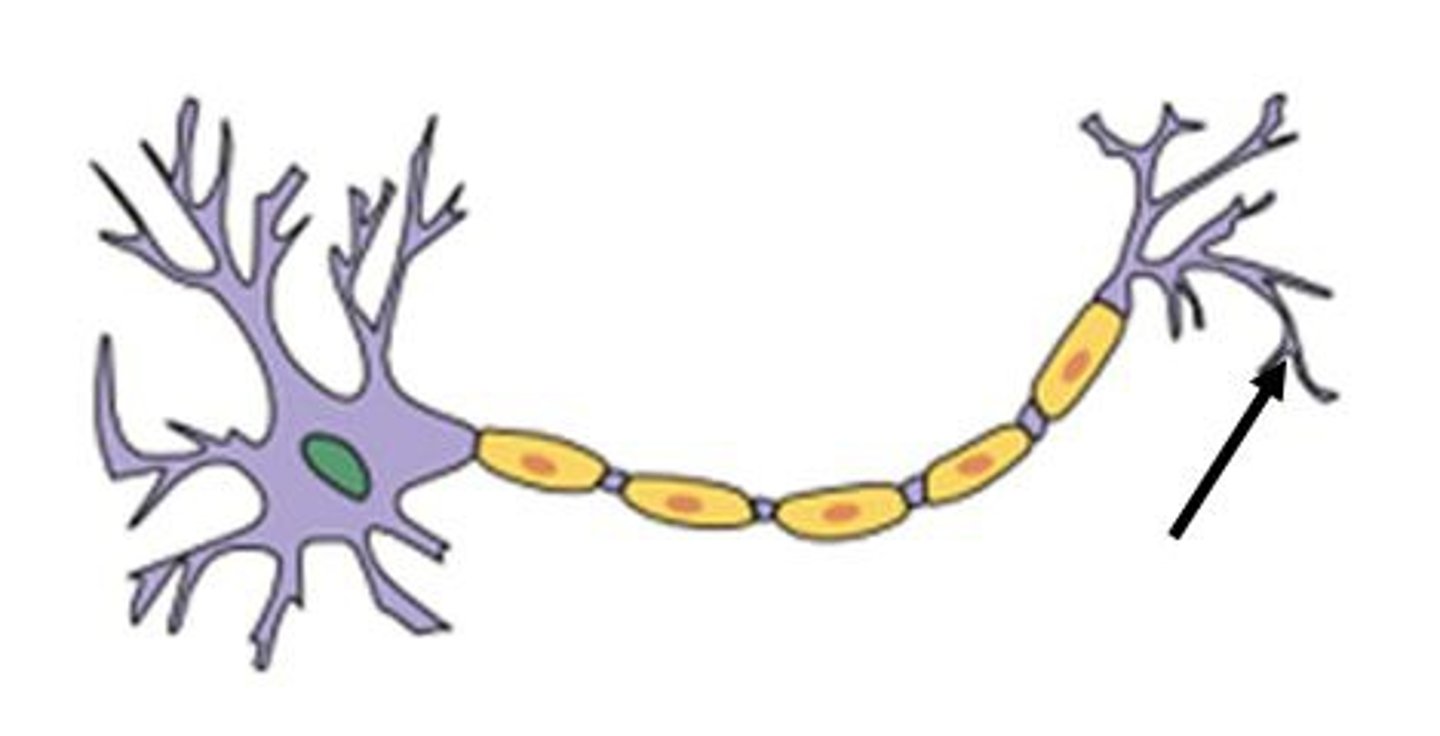
Action potential
a neural impulse; a brief electrical charge that travels down an axon- occurs when a neuron receives an excitatory signal
Depolarization
The process of making a neuron less negative- can be when a positively charged ion enters or a negatively charged ion exits
Repolarization
The process of returning a neuron to a more negative value. Can be when a positively charged ion exits or a negatively charged ion enters.
Synapses
Neuron to neuron connections that are made onto the dendrites and cell bodies of other neurons
Presynaptic neuron
Neuron that sends the signal
postsynaptic neuron
the neuron on the receiving end of the synapse
Neuromuscular junctions
The synaptic connection between neurons and skeletal muscle cells
Neuroeffector junctions
Connections between neurons and smooth cell types or glands
Neurotransmitters
Chemical messengers that transmit information at the sites of most synapses and junctions
Glial cells
support cells found in the nervous system
Astrocytes
most numerous type of glial cell, and have a variety of functions such as contributing to the formation of the blood brain barrier, helping neurons find their ways to destinations, regulating blood flow in the brain, e.t.c.
What glial cell helps maintain the composition of fluids that surround neurons?
Astrocytes
Microglia
related to the macrophages of the nervous system, help remove dead cells and debris
Oligodendrocytes
CNS cells that produce and wrap the myelin sheath around the axons of many neurons
Schwann cells
Have the same function as Oligodendrocytes except in the PNS
Satellite glial cells
Cover the cell bodies of neurons in the PNS
Ependymal cells
CNS neurons that line the ventricles of the brain and have hairlike cilia that beat to promote the circulation of cerebrospinal fluid found inside the ventricles and spinal canal
Hypothalamus
a peanut sized structure deep inside the brain that contains groups of nerve cells that act as control centers affecting sleep and arousal.
suprachiasmatic nucleus
a cluster of cells within the hypothalamus that receive information about light exposure directly from your eyes and control your behavioral rhythm.
Sleep helps to balance which two hormones?
Ghrelin and leptin
Ghrelin and leptin
Ghrelin is a hormone that increases your appetite and plays a role in maintaining body weight. Leptin is a hormone that decreases appetite.
Gray matter
a type of tissue that is mainly composed of neuronal cell bodies and unmyelinated neurons
white matter
a type of tissue that is mainly composed of long range myelinated axons that transmit signals to the gray matter.
Alzheimer's disease
the most common type of irreversible dementia- affects neurotransmitters and chemicals, disturbing memory, impairing thinking, and causing behavioral changes over time
Sporadic Alzheimer's
the most common form which occurs after age 65
Familial Alzheimer's
caused by a rare genetic condition and results in dementia, usually in people in their 40's and 50's
Amyloid plaques and Alzheimer's
deposits of amyloid plaques outside the brain cells which prevent the brain from passing signals properly
Neurofibrillary tangles and Alzheimer's
deposits inside the brain cells, they kill cells by blocking off food and energy, causing dementia that worsens over time
Neuronal death and Alzheimer's
causes shrinking in the outer layer of the brain, which is vital to memory, language, and judgment. Alzheimer's is characterized by the shrinking.
Epilepsy
a long-term condition where a person has repeated seizures.
Other causes of seizures
alcohol withdrawal, diabetes, heart conditions, fever.
Symptoms of epilepsy
unusual eye movements, sudden, temporary confusion, rigid muscles, difficulty talking
common contributing factors of epilepsy
brain infections such as meningitis or viral encephalitis (inflammation of the brain), brain tumor, head trauma, or stroke/blocked blood supply to the brain
risk factors of epilepsy
injury of infection to the mother, inherited genetic defect, neurological disorders such as autism or types of dementia
benign rolandic epilepsy
a type of epilepsy, thought to be inherited. makes up 15% of epilepsy cases in children and usually stops around ages 14-18
panayiotopoulos syndrome
a type of childhood epilepsy that starts between ages 3 and 10. seizures usually stop after around 3 years
rasmussen's syndrome
the type of epilepsy in which the immune system attacks brain cells and causes inflammation that can lead to brain damage.
juvenile absence epilepsy
this type of epilepsy usually begins around ages 10 and 17. it is a lifelong condition that requires medication. can cause attention and memory issues.
juvenile myoclonic epilepsy
the most common generalized type of epilepsy. starts in mid-late childhood, around the ages of 5 to 16.
multiple sclerosis
A potentially disabling autoimmune disease of the brain and spinal cord (central nervous system) in which the immune system attacks the myelin sheath that covers the axons of many neurons. Causes communication problems between the brain and the rest of the body.
Lhermitte sign
electrical feeling down the back with neck flexion, a symptom of Multiple sclerosis.
parkinson's disease
A neurodegenerative disease in which associated brain damage is restricted to a specific area (substantia nigra in the midbrain), leading to the impairment of motor abilities. This disease affects dopaminergic neurons that produce dopamine.
potential causes of parkinson's
environmental triggers or genes in rare cases
Alpha-synuclein
A natural and wide spread protein found in clumps that cells cannot break down; a current cause of research in PD
Lewy bodies
Clumps of proteins observed in the surviving dopaminergic neurons of Parkinson's patients
Chemoreceptors
chemical sensors in the brain and blood vessels that identify changing levels of oxygen and carbon dioxide; found mainly on the tongue and in nasal passages
Thermoreceptors
detect changes in temperature; found mostly in the skin and detect temperatures that are above or below body temperature
Mechanoreceptors
respond to touch, pressure, vibration, stretch, and itch
photoreceptors
detect light during vision, mostly found in the eye and are needed for the sense of vision